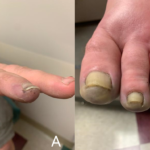 ACR Convergence 2021—During ACR Convergence 2021, rheumatologists and other healthcare providers heard experts describe how best to distinguish between infection or malignancy and autoimmune disease in critically ill patients. The presentations emphasized that the diagnosis of autoimmune disease can be especially time sensitive in patients with multi-system organ failure. The speakers also described a management approach for critically ill patients, highlighting common mimics and warning signs of dangerous manifestations of rheumatic disease.
ACR Convergence 2021—During ACR Convergence 2021, rheumatologists and other healthcare providers heard experts describe how best to distinguish between infection or malignancy and autoimmune disease in critically ill patients. The presentations emphasized that the diagnosis of autoimmune disease can be especially time sensitive in patients with multi-system organ failure. The speakers also described a management approach for critically ill patients, highlighting common mimics and warning signs of dangerous manifestations of rheumatic disease.
Digital Ischemia
Paul F. Dellaripa, MD, associate professor of medicine at Harvard Medical School, Boston, spoke first, addressing digital ischemia as a harbinger of critical illness in rheumatology. He explained that digital ischemia in rheumatic diseases can result from local tissue ischemia or represent a systemic process. In the case of local digital ischemia, such as Raynaud’s disease, Dr. Dellaripa suggested eliminating offending drugs (e.g., beta blockers). Patients can then be treated with vasodilators, Botox injections, sympathectomy, intravenous prostacyclin or anticoagulation.
He presented a case to demonstrate that alteration or evolution of the clinical phenotype in patients with one disease, such as systemic lupus erythematosus (SLE), may develop features more consistent with another disease, such as scleroderma.
Next, Dr. Dellaripa presented several dangerous manifestations of rheumatic disease, beginning with thrombotic microangiopathy.1 He explained that thrombotic microangiopathy differs from microangiopathy because, in addition to being a disease of small blood vessels, patients with thrombotic microangiopathy experience microangiopathy with ischemia due to fibrin formation and/or platelet aggregations. Thrombotic microangiopathy causes the occlusion of arterioles and capillaries and can be primary or secondary. Primary thrombotic microangiopathies include thrombotic thrombocytopenia purpura and atypical hemolytic uremic syndrome. Secondary thrombotic microangiopathies arise as complications of underlying disorders, such as scleroderma renal crisis, cryopyrin-associated autoinflammatory syndromes and SLE.
Rheumatic disease may also manifest as macrophage activation syndrome (MAS), which is a secondary form of hemophagocytic lymphohistiocytosis that can be seen in approximately 10% of patients with systemic juvenile idiopathic arthritis and 0.9–4.6% of patients with SLE.2 The mortality from MAS-associated lupus can be as high as 35%.
Ischemic changes can serve as a marker or harbinger for more profound systemic disease, warned Dr. Dellaripa.3 Moreover, microinfarcts and angiopathic changes can be catastrophic with heart, kidney or lung involvement.4 According to Dr. Dellaripa, treatment of patients who present with these dangerous manifestations can be challenging and often requires anti-inflammatory therapy with anticoagulation. Patients may also benefit from emerging therapies, such as anti-complement therapy eculizumab, sirolimus or defibrotide.



